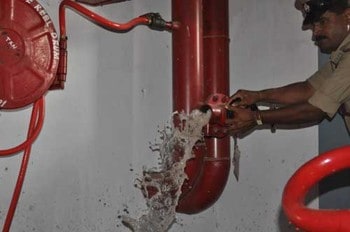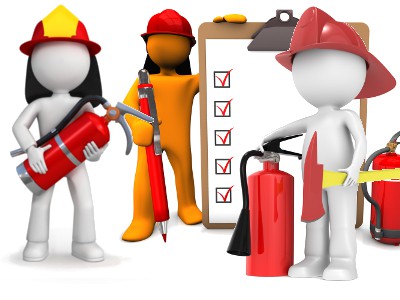Healthcare facilities such as hospitals and nursing homes normally see a continuous flow of people. Almost all of them operate on a 24×7 basis. Hospitals are not only required to take care of patients but must ensure that their safety is prioritised. Fire accidents at healthcare facilities should not force anyone to run for their life.
Ever since COVID-19 made an appearance, medical facilities have been stretched beyond their capacity. Right in the middle of the pandemic, when work load of hospitals has been on an all-time high, there have been several instances of hospital fires resulting in tragedies, across India. The Ministry of Home Affairs issued an advisory to all States, directing them to ensure that hospitals and nursing homes comply with fire safety protocols.
Read more: In schools, hospitals or shrines, you can’t escape fire risk in urban India
Focus on fire safety becomes very important as hospitals are an amalgamation of a wide range of services. They have core functions such as diagnostic and treatment functions, clinical laboratories, imaging, emergency rooms and surgery. Besides this, they have hospitality functions such as food service and housekeeping. Its infrastructure houses many heat-dissipating equipment, combustible gases and fuels, chemicals, electrical wiring and the like.
Basic principles of fire safety
There are three basic principles that all hospital could adopt to prevent fire accidents. And in an eventuality, these basic principles can prevent damage to lives and property. They are: prevention, protection, preparation
Prevention: Following electrical, housekeeping hygiene
- Ensure that electrical points are not overloaded. Make sure that a 15 amp plug is not inserted into a 5 amp switch.
- Check all electrical cords for frays or tears.
- Keep passageways clear of any obstructions.
- Keep generator rooms, elevator shafts, electrical/ducts/panels, etc., clear of any combustibles; PPE kits, cartons, plastic waste.
- Maintain at least 2-3 metres distance between electrical equipment and combustible material.

Read more: Check your home’s fire safety, take part in the ‘iamfiresafe’ campaign
Protection: Creating infrastructure for emergencies
- Overhead sprinklers: Sprinklers are by themselves like a small fire fighter which helps curtail the spread of fire.
- If sprinklers are unavailable, a simple hose pipe which is connected to a water source can also help. In most buildings they have hose reels for such purposes.
- Fire Extinguishers
- The right kind of extinguishers should be installed in the appropriate area, ICU, passageway, kitchens, electrical rooms, etc.
- Ensuring that sufficient number of extinguishers are kept at regular intervals – every 15 metres.
- Extinguishers should be installed at chest level, for easy access.
- Instructions have to be posted along with the extinguishers so that in an emergency anyone can deploy it.
- Public Address (PA) System: provides hospital operators with a way to disseminate instructions.
- Signages: Ensuring that luminescent signages are placed at floor level also. In the eventuality of a fire, smoke rises above ground. For people crawling under the smoke at ground level, these signages are visible.
- Kitchen and Laundry
- Avoid grease fires by emptying appliances’ grease traps on a regular basis.
- Store flammable liquids, oils or other items far away from cooking equipment.
- Keep portable fire extinguishers (including dry chemical extinguishers) close by and ensure that the staff knows how to operate them.
- Chemicals
- Pay special attention to areas where flammable chemicals are stored. These areas should not be accessible to the general public.
- Ensure that no fire/smoke comes in contact with this area such as cigarette, agarbatti, candle, etc
- Fire lift is meant for fire personnel only, not for public, during an evacuation. Fire lifts are designed to withstand heat for an hour or so, to help fire personnel reach higher floors for containment and rescue. Public should always use the staircase in case of fire and not any lift.

Preparation: Establishing a routine
- Training: Conduct regular training exercise for staff on how to identify the sources and types of fire, how to use fire fighting equipment, mock drills and evacuation strategy.
- Check all electrical cords for frays or tears. At Least two people should be assigned to check all the electrical equipment/room/shafts etc.
- On a daily basis such as hose, hydrants, extinguishers, etc., to ensure that they are in working condition. Only the Sprinkler system cannot be checked on a daily basis, hence it is kept in automatic mode. Make sure the functioning of the fire protection system is working in automatic mode.
- Inspect all electrical points every couple of hours to see that they are not overloaded. Switch off any device not in use.
- Communication: Ensure that the PA system is functioning properly, utilize it to manage crowds/instruct people regularly so that people learn to pay attention and follow instructions given.
- Fire and smoke alarms, etc have to be in working condition at all times. So, all the staff can be alerted at once if there is a fire. Fire suppression systems are some of the best ways to keep small fires from turning into large emergencies, keeping them serviced and working order.
- Ensure that sprinklers, hose systems, hydrants are connected to a functional water source and the sprinklers are kept on an Automatic Mode.

When a hospital is overloaded, some of the routine inspections take a back seat. With the demand for more beds with oxygen is increasing and the government is focusing on opening Covid Care Centres and re-opening defunct Hospitals, Nursing Homes, Primary Health Care centres, etc., focus towards fire safety becomes paramount.
“Whilst an exhaustive checklist and audit according to the National Building Code is a must do, if hospitals just follow these simple things along with their day to day activities, it can help avert disasters. Fire safety is common sense at the end of the day.
Sumit Khanna, Beyond Carlton